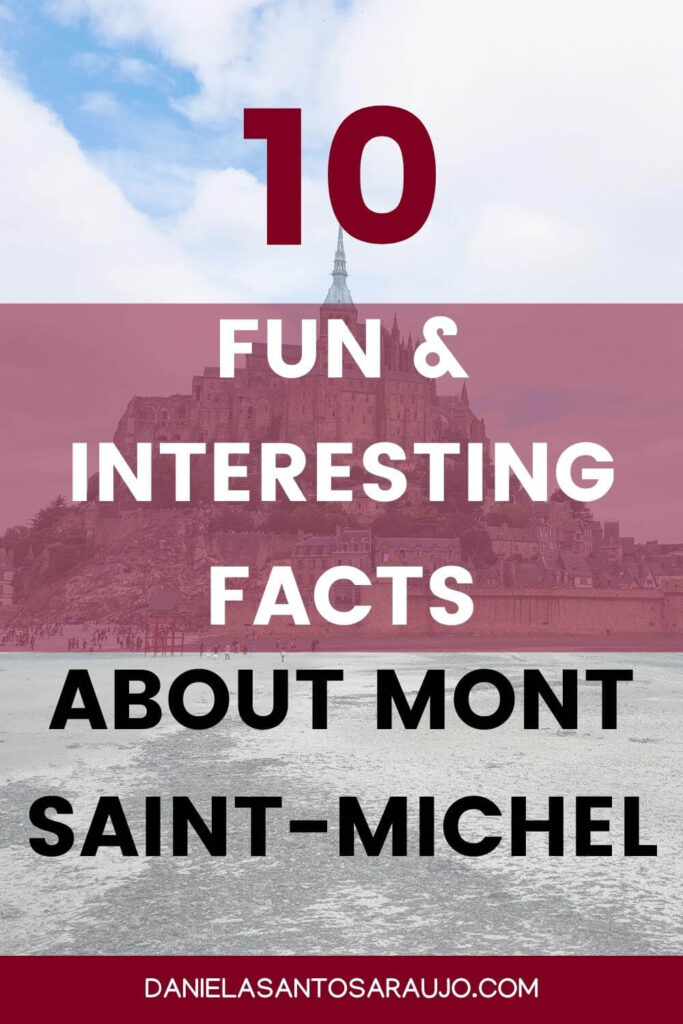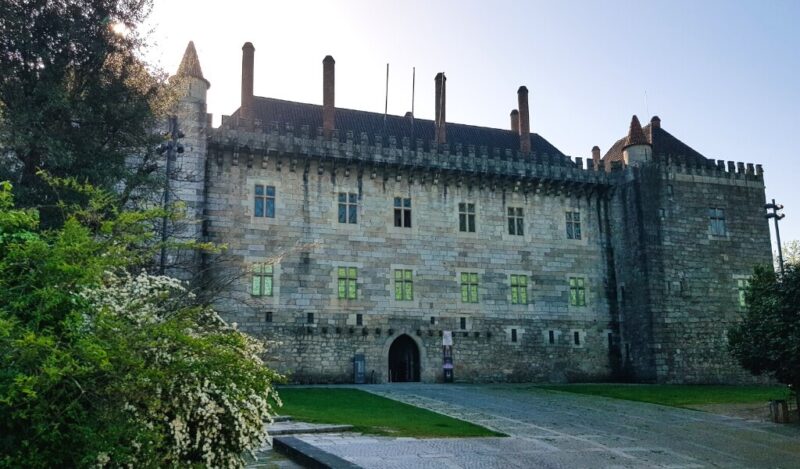Mont Saint-Michel is, by far, the most indescribable place I’ve ever visited in France. And although many people have already heard about this magical place in the Normandy region, I’m sure I found ten things you probably didn’t know about Mont Saint-Michel!
In 1979, Mont Saint-Michel and its Bay were inscribed on the UNESCO World Heritage list, which contributed to the recognition of their historical and architectural value. But when it comes to fun and interesting facts, hidden gems, and secret places, there’s still a lot to reveal!
So, do you want to know more about the 10 Fun & Interesting Facts About Mont Saint-Michel? Keep reading!
This post may contain affiliate links, meaning I earn a small commission if you make a purchase, at no additional cost to you. Please read my disclosure & privacy policy for more information.
No time to read now? Pin it for later!


- 1. Mont Saint-Michel was born of a vision
- 2. Mont Saint-Michel follows the hierarchy of feudal society
- 3. In the Middle Ages, Mont Saint-Michel was the second most important pilgrimage site in Europe
- 4. Mont Saint-Michel was never conquered
- 5. The Abbey of Mont Saint-Michel once served as a prison
- 6. Mont Saint-Michel has a "twin brother"
- 7. There's a hidden chapel on the island
- 8. Mont Saint-Michel's omelets are the most famous in Normandy
- 9. The smallest street in Mont Saint-Michel has a "funny" name
- 10. Mont Saint-Michel has inspired the Seventh Art
- More Posts about France
- More Posts about Religious Temples
- More Posts about World Heritage
- What Photography Gear Do I Use?
1. Mont Saint-Michel was born of a vision
Did you know that Mont Saint-Michel was born of a vision? Legend has it that, at the beginning of the 8th century, the Archangel Michael appeared to Aubert, Bishop of Avranches (and future Saint Aubert) in a dream and told him to build a sanctuary in his honor, on this rocky and inhospitable island.

In the first two apparitions, Aubert ignored this unusual request, but the Archangel Michael returned a third time and touched his head with one finger, leaving a hole! These days, Saint Aubert‘s skull is on display at the Basilique Saint-Gervais d’Avranches and the orifice is very visible!
2. Mont Saint-Michel follows the hierarchy of feudal society
During the Middle Ages, Western Europe was governed by feudalism, a social, political, and economic system consisting of a regime of vassalage and serfdom. Basically, the fall of the Roman Empire and the successive invasions of barbarian peoples caused the population to flee from the big cities to the countryside.
These rural areas were managed by nobles (the feudal lords), who lived off taxes from agricultural and livestock workers. At Mont Saint-Michel, God and the abbey (ie, the clergy) are at the top; next, are the noble residences and shops; and at the base are the houses of peasants and fishermen, outside the walls.
3. In the Middle Ages, Mont Saint-Michel was the second most important pilgrimage site in Europe
One of the many fun and interesting facts about Mont Saint-Michel is that, during the Middle Ages, this was the second most important pilgrimage site in Europe, right after Santiago de Compostela, in the region of Galicia, Spain.

As the Archangel Michael had promised Saint Aubert, Bishop of Avranches in his three visions, thousands of pilgrims began to arrive as soon as the abbey was completed. And since the trip was so difficult to make, the faithful came to see it as a true proof of penance and commitment to God!
4. Mont Saint-Michel was never conquered
Many were the people who tried to invade and conquer Mont Saint-Michel from the French, but none were successful. Not even the English during the so-called Hundred Years War – a series of conflicts between the two kingdoms, which ran from 1337 to 1453.
All this was due to the massive fortifications on which the abbey and medieval village of Mont Saint-Michel were built. In addition, the high tides and shifting sands that surrounded (and still surround) this rocky island helped to deter both land and sea attacks!
5. The Abbey of Mont Saint-Michel once served as a prison
Mont Saint-Michel was and has been for centuries one of the main places of worship and pilgrimage in France and Central Europe. However, there was a very particular period in the country’s history when Mont Saint-Michel served another purpose: that of prison, in the French Revolution (1789-1799).
During the French Revolution, the Abbey of Mont Saint-Michel was converted into a prison and earned the nickname “Bastille of the Sea” – an allusion to the Bastille (formerly called Bastille Saint-Antoine), the medieval fortress in Paris, which was turned into a prison in the 17th and 18th centuries.
6. Mont Saint-Michel has a “twin brother”
Almost everyone considers it a unique place in the world (and it is, to some extent), but the truth is that Mont Saint-Michel has an English “twin brother” called St Michael’s Mount! If you want to visit St Michael’s Mount, all you have to do is travel to Cornwall, a county in the southeast of England.

Despite being much smaller than its French namesake, St Michael’s Mount shares some characteristics with Mont Saint-Michel, namely the fact that both are “tidal islands” (that is, portions of land connected to the continent by bridges, which get submerged at high tide).
7. There’s a hidden chapel on the island
The thousands of tourists who visit Mont Saint-Michel always follow the same route: they cross the long walkway to the island, walk the main street of the historic center to the abbey, visit its interior and enjoy the views, turn back and go explore tourist shops, cafes, and restaurants along the way.
Well, one of the best curiosities and interesting facts about Mont Saint-Michel is that there’s a small chapel hidden at one end of the island, more precisely behind the abbey itself! It’s called the Chapelle de Saint-Aubert and was built in the 12th century, in honor of Bishop Aubert de Avranches.
8. Mont Saint-Michel’s omelets are the most famous in Normandy
In 1873, Annette Poulard opened an inn and decided to create a simple and quick dish (but, at the same time, hot and consistent), to comfort the thousands of pilgrims who arrived exhausted and hungry from their difficult journey to Mont Saint-Michel.


Almost 150 years later, Mère Poulard’s Omelet Souffle remains a gastronomic specialty and a cultural icon in this medieval village, as well as in the entire Normandy region! So, if you’re thinking about visiting Mont Saint-Michel, don’t forget to book a table at La Mère Poulard.
9. The smallest street in Mont Saint-Michel has a “funny” name
If you head to Hôtel La Croix Blanche in the heart of the Grande Rue (the main street of Mont Saint-Michel), you’ll find stone stairs, which lead to a small street in front of this tourist accommodation, practically hidden by the awnings of the souvenir shops.
The street is called Venelle du Guet and doesn’t appear on maps or GPS because it’s that small! However, if you talk to the locals, you’ll find out that the inhabitants have decided to give it another name: Ruelle des Cocus (ie “Alley of the Horns”)! Why? Because the street is so narrow you can’t walk by with horns… hence the name!
10. Mont Saint-Michel has inspired the Seventh Art
Did you know that this rocky island has inspired one of Walt Disney‘s best-known animated movies? Tangled (2010) is Disney‘s adaptation of Rapunzel, the Brothers Grimm fairy tale. And in this version, the “lost princess” was born in Corona, an enchanted kingdom whose graphics were based on Mont Saint-Michel!

Before the movie Tangled, it’s thought that Mont Saint-Michel had already been an inspiration for Peter Jackson (the director, screenwriter, and film producer of the Lord of the Rings trilogy), particularly in the conception of the town of Minas Tirith, the capital of the Kingdom of Gondor.
Share this blog post on your social media!
More Posts about France
Gustave Moreau Museum: Best Tips For Visiting In 2024
Museum Of Romantic Life: Best Tips For Visiting In 2024
Marmottan Monet Museum: Best Tips For Visiting In 2024
More Posts about Religious Temples
Jewish Museum Of Prague: Best Tips For Visiting In 2024
4 Best Monasteries In Portugal (That You Should Visit This Year)
How To Visit The Sanctuary Of Sameiro In 2024
More Posts about World Heritage
Palace Of The Dukes Of Braganza: Best Tips For Visiting In 2024
World Heritage In Castile And León (2024)
Machado De Castro National Museum: Best Tips For Visiting In 2024
What Photography Gear Do I Use?
- Camera Body: Fujifilm X-T4 Mirrorless
- Camera Lens: Fujinon XF 18-55 mm F2.8-4 R LM OIS
- Tripod: Manfrotto Compact Action
- Small Tripod: Manfrotto PIXI Mini
- Smartphone Adaptor: Manfrotto PIXI Clamp
- Memory Card: SanDisk 128GB Extreme PRO SDXC
This blog post uses stock photographs (Getty Images)









